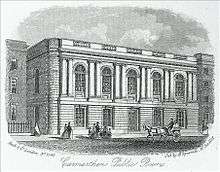Carmarthen Public Rooms
The Carmarthen Public Rooms were built in 1854,[1] with the intention to create public rooms were first expressed by Dr David Lloyd in 1839.[2]

Commonly referred to as the "Assembly Rooms" the building was designed by James Wilson (architect) of Bath [3] on the site of the Scurlock family town house, where Sir Richard Steele, founder of The Spectator, died in 1729. The site was occupied by The Ivy Bush inn [4] until c1801, and was then premises of the Timmins family, timber merchants.
The Assembly Rooms had a 5-bay, 2-storey Italianate stucco facade with balustraded parapet, cornice, arched first floor windows between paired pilasters, and channelled ground floor with recessed sash windows and centre door.
In 1918 an article appeared in the Carmarthen Journal stating that in future the Carmarthen 'Assembly Rooms' were to be called 'The Lyric'.[5] But this building is actually the old Post Office building which stands to the left of the Lyric Theatre, which was constructed in the 1930s
The Lyric is a theatre, one of the largest in West Wales and hosts theatre, touring productions, comedians and music. Since 2005, the Lyric has been owned by Carmarthernshire County Council. Prior to this the building was saved by a trust headed by Elizabeth Evans, who formed the Carmarthen and Districvt Youth Opera.
The old Post Office building is currently unoccupied since the post office moved to WH Smiths, further in the town.
References
- The Welshman, 1854
- Carmarthen Journal, 16 March 1839
- The Welshman, 1854
- The Welshman, 1854
- Carmarthen Journal 1918
- "Archived copy". Archived from the original on 13 February 2013. Retrieved 2013-02-01.CS1 maint: archived copy as title (link)